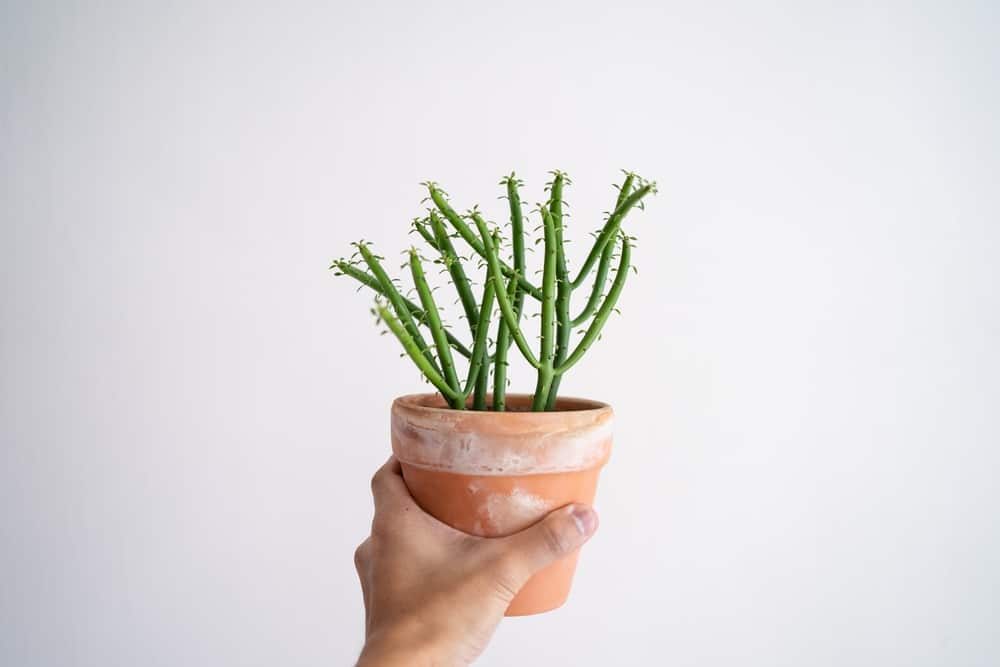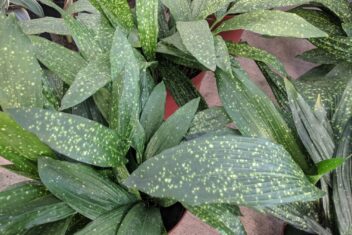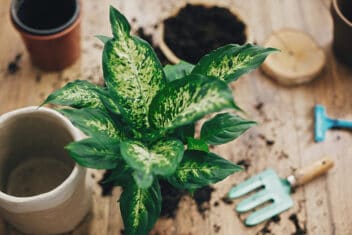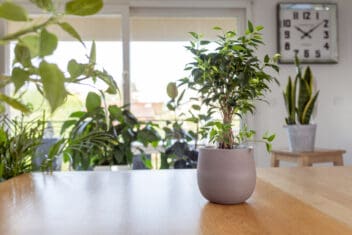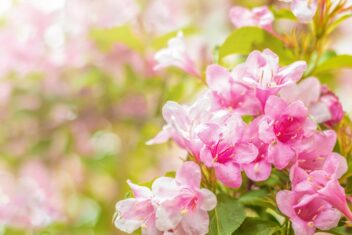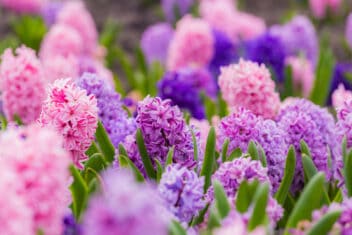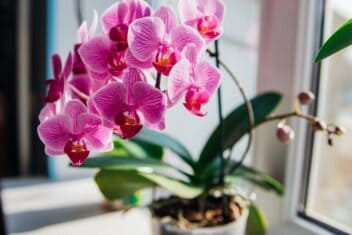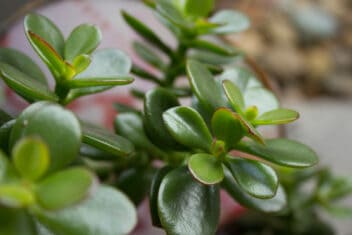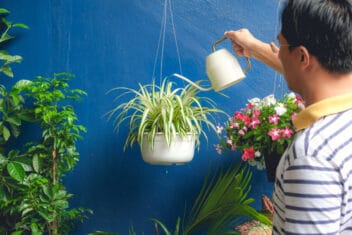In my seemingly never-ending quest to find house plants that are both unique and easy to care for, I came across pencil plants a few years ago. Apart from those two criteria, my third is that I need plants that can either withstand or thrive on neglect, and pencil cactus really fits the bill.
If like me, you’re busy on the homestead, at an off-site job, or don’t want fussy house plants, I can assure you pencil cactus is the indoor plant for you. With its unique look and lack of needs, it’s an indoor plant you won’t regret trying.
What is Pencil Plant?
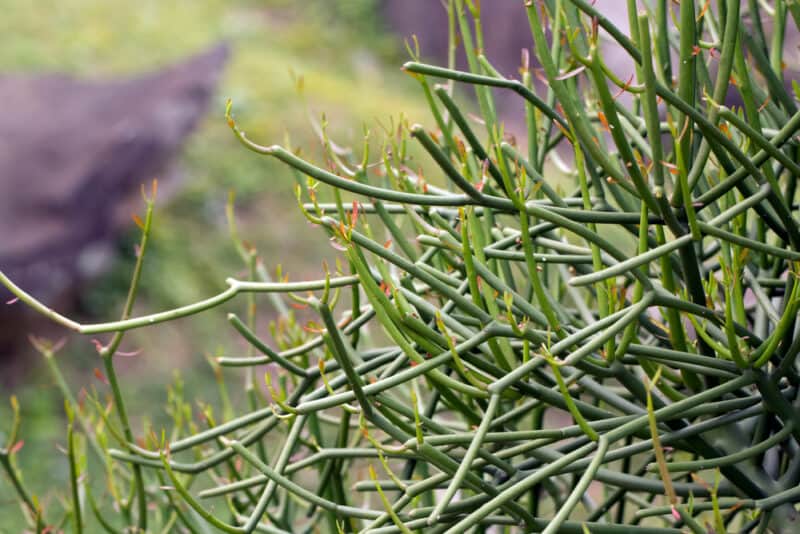
Pencil plant (Euphorbia tirucalli) is actually a succulent, rather than a true cactus. Its photosynthesis takes place in its stem, not the leaves.
Sometimes called milk bush, because of the white latex-type sap that comes when the plant is cut, be aware that the sap is toxic.
You may also see this plant called pencil cactus, pencil tree, fire sticks, fire stick tree, or Indian tree spurge. It has a lot of names!
Originally from its native areas of Africa and India, this is a plant that loves the semi-arid environment that it comes from.
More commonly grown as an indoor house plant, it will also thrive outside in the right environment. Just be aware that it can grow outside quite quickly to about 30 feet tall and six feet wide.
Inside it can grow to six to eight feet if you allow it to, and this is a plant that will happily take the sunniest spot in the house.
You can grow pencil cactus outside if you live in USDA Growing Zones 11 and 12. It will grow quickly and up to 30 feet tall and six feet wide. If you have a sunny area with that amount of space try growing it outside.
Outside those zones, pencil cactus needs to be planted in pots inside as a house plant.
The optimal temperature to grow pencil plants is 65-75ºF. Anything below 50ºF, say goodbye.
How to Propagate Pencil Cactus
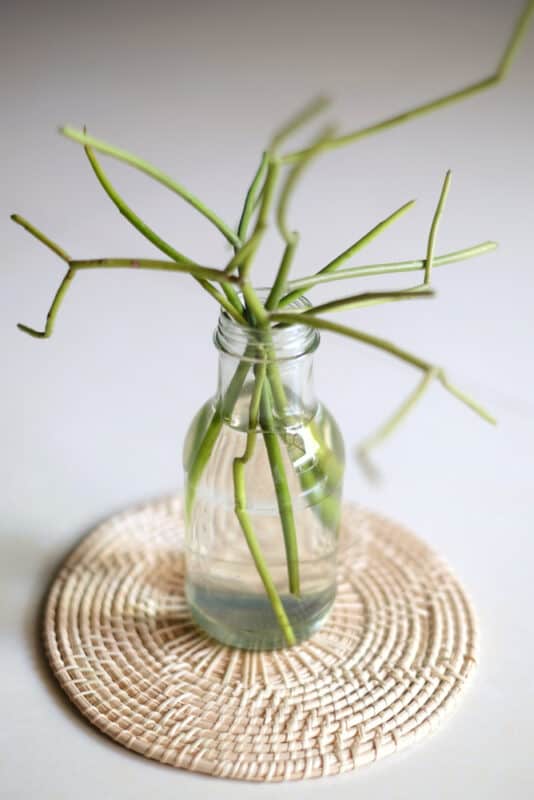
Pencil cactus is super-easy to propagate from cuttings. You must wear gloves and consider wearing eye protection because the sap can cause severe irritation to the skin, especially to those with an allergy to latex. Also, this plant is toxic to animals, so don’t allow pieces to drop to the floor.
- Take a six inch stem cutting.
- Dip it in a glass of water to stop the sap from flowing freely.
- Place the cutting on a paper towel and allow to dry for about a week. You want the end to form a callous to stop it from rotting when you plant it.
- Plant in a small container filled with a mix specific to succulents or cacti that you have moistened first. Only respray the soil mix when it is dry. Overwatering may cause the cutting to rot or die.
Growing Indoors

Pencil cactus is a survivor. It doesn’t require lots of water or feeding, but it is fussy on placement.
Because pencil cactus likes to have the soil dry out, use an unglazed clay pot so the moisture can evaporate through the sides.
There should be plenty of drainage holes in the base. It’s important the root system of cactus pencil doesn’t sit in wet soil.
Choose your sunniest window. This is not a plant that only wants indirect sunlight. It loves full sun, just not too close to the glass that it gets magnified sunlight. The temperature should be between 65-75ºF with no sudden cold winds from doors, windows, or AC units.
A south-facing window is perfect, especially if humidity is low. Pencil plants will be okay with a little humidity, as long as it doesn’t prevent the soil from drying out.
The right growing medium is important. The pH should be around 6.0. A good quality cactus or succulent growing medium is best, but double-check the pH level.
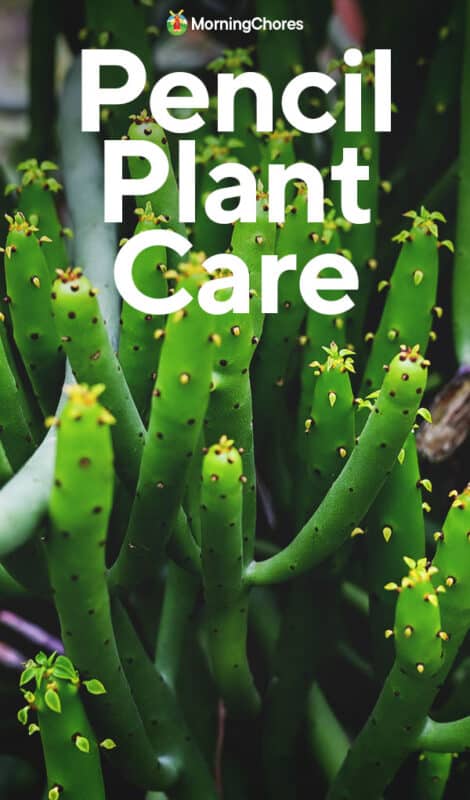
Water
Watering pencil cactus is where many people go wrong. After all, wouldn’t a plant sitting in full sun want lots of water? The answer is a resounding no. Remember, this is a succulent.
Allow the soil to dry out completely after watering. I would go so far as to say if the soil is slightly moist and you’re unsure about watering or not, don’t. Come back in a day or two, and if the soil is now dry, give it a light watering.
If you’re new to pencil cactus and a little nervous about over or under-watering, I water mine every ten days or so. That’s how low-maintenance they are.
In the winter they require less watering, down to about once a month.
Fertilizer
Use a well-balanced houseplant fertilizer. I prefer to use a cactus or succulent-specific fertilizer, because you feed pencil cactus so infrequently that it’s best to give it the perfect amount and type of nutrients it needs.
Feed once in the spring when the sun begins to warm, and that will be enough for the year.
Repotting Pencil Cactus
Pencil cactus will withstand cramped pots up to a point, but they’re easy to repot if you follow a couple of suggestions. Repot if all the drainage holes are showing thick root growth.
- Only repot if the soil is dry.
- Cut off any dead, dying, black or shriveled roots.
- Once repotted, don’t water for about a week.
Growing Outside
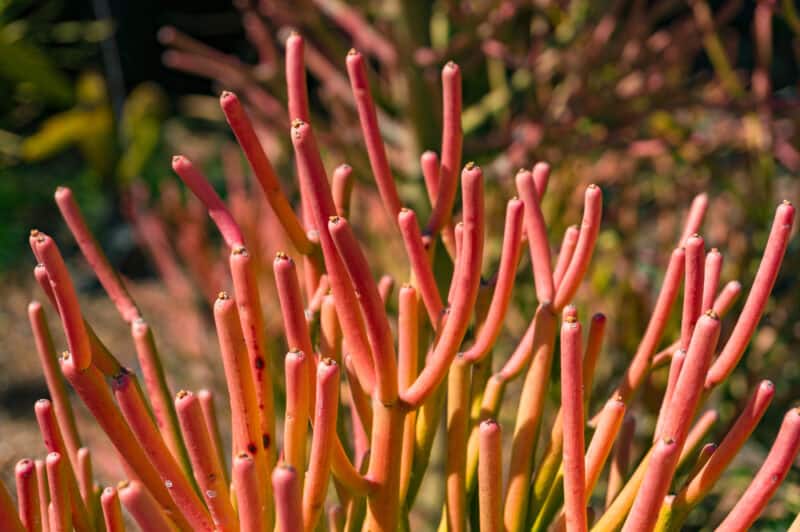
Pencil cactus is a perfect choice for a sunny area as long as there is space. Plant it somewhere people or pets won’t brush past and be exposed to the milky sap which may irritate their skin if they accidentally break a piece off. Remember pencil cactus is toxic to pets.
Choose a site with full sun all day. The soil must be well-draining, so it’s best to dig a hole twice the size of the root ball you are planting, and use bagged cactus soil if you are able.
Consistent temperatures of 65-75ºF are needed. Anything below 50ºF you will need to plant in pots and move inside as the temperatures cool.
As with indoor pencil cactus, water infrequently about once a fortnight, but make sure the top three inches of soil have dried out before re-watering. Feed with a balanced cactus or succulent fertilizer once a year in spring.
Companion Planting for Pencil Cactus
In the cooler times of the year, the pencil cactus provides various bright shades of yellow, pink, and orange. Plant similar plants that are drought tolerant.
- Angelina creeping sedum (Sedum Rupestre): A great ground cover with similar cool weather colors.
- Sedum Firestorm: Perfect for the border around pencil cactus.
- Campfire (Crassula Capitella): Shades of red and green match the much larger pencil cactus.
- African Daisy: Will bloom on the cooler days when pencil cactus change color.
- Hummingbird Plant: Grows to about two feet tall and is indestructible, just like pencil cactus.
Common Problems and Solutions for Growing Pencil Cactus
One of the best things about pencil plants is how easy it is to care for. It’s rarely troubled by pests and diseases. But that doesn’t mean it’s immune to problems. Here are the things to watch for.
Drooping
Just like it’s name, pencil cactus should be upright and look like a bunch of pencils at different angles. Drooping can be caused by a few things.
- Overwatering: This is the most common cause of drooping and is usually because growers new to pencil plants are nervous about not giving enough water. If you do overwater, allow the soil to dry out completely. Don’t water again for two weeks, and in the third week, water lightly.
- Compacted Soil: This can cause water to sit and stop it from draining. This may eventually lead to root rot, but one of the first signs is drooping or mushiness of the stems. Repot and use a cactus or succulent specific potting soil.
- Heat Stress: Pencil plants love direct sunlight. Where a plant can become heat-stressed is if you place a pencil cactus too close to a heater. Simply reposition the plant.
- Over-Fertilization: Remember to fertilize once a year with a cactus or succulent specific fertilizer. Follow the instructions on the pack.
- Insufficient Light: Being a sun lover, direct sunlight is required. Choose a south-facing window and monitor the plant’s condition. If a pencil cactus droops due to low light levels, it will recover in about three days once moved to more direct sunlight.
Spider Mites
Spider mites are the most common pest for pencil cactus. Read our article on how to identify and deal with spider mites here.
Mealybugs
You often find mealybugs on a pencil cactus that has been weakened due to over-watering. They can be very destructive when their numbers build up.
Read our article on how to identify and deal with mealybugs here.
Root Rot
Due to the need for sparse watering, well-draining soil, and minimal fertilization, pencil plants will suffer from root rot if those conditions are not adhered to.
Here is the method I used when someone over-watered my pencil cactus and it got root rot. It looked droopy and started to yellow. Some of the stems were mushy and the soil in the pot had a rotten smell to it.
- Carefully remove the pencil cactus from the pot.
- Dispose of the soil.
- Trim away any rotting roots, or any that are black, mushy or clearly unhealthy.
- Carefully remove as much of the soil as possible.
- Coat the remaining roots with powdered sulfur, copper fungicide, hydrogen peroxide, or powdered charcoal.
- Place the plant in a warm dry area for two to three days. Cover it with a shade cloth to protect it.
- Clean the pot with disinfectant and dry well.
- Repot the pencil cactus in clean, dry cactus or succulent potting soil.
- Water in a week.
